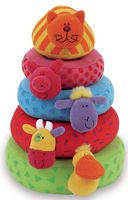
Accelerating Baby’s Learning Rate With Toys
David Rakison, a psychologist at Carnegie Mellon University in Pittsburgh seems to agree that babies start the learning process early. “The ‘smart baby’ camp believes that babies learn quickly.” “They do math—[simple] addition and subtraction—within the first 6 months,” he says.
Having studied a number of journal and thesis written on how babies learn in addition personal experiences and observations, I have concluded it’s the environment. There is much scientist must still discovering about how the baby’s brain functions. But, regardless of how the brain function the lessons babies learn are provided by the environment they are in. It is generally agreed that learning begins in the womb and continues throughout childhood. Their environment includes all the objects they can see and touch and all the sounds they hear. They use all of their senses in the learning process. Babies are always learning.
Caretakers and parent are most valuable part of the environment. “Infants are learning how thing move around in the world by watching their caretakers do actions and then deciding which things are like those objects, based on having the same parts. Then, they model the action,” Rakison says. There are other researchers who argue babies take their time and slowly learn what they need to know. My personal experiences support the Rakison’s position.
Every parent wants to see his or her child get off to a fast start when it comes to learning and brain development. Knowing basic information about how babies learn allow parent to establish the proper learning and development environment for their baby. The parent is baby’s first playmate—the one who provides a safe environment for baby to explore, play and interact with to provide fun and interest. Babies will also go through a discovery period when they will entertain themselves with their body parts—fingers, toes, hands, legs and feet.
To further contribute to babies development and learning there are thousands of educational toys available. The challenge parent, educators, and childcare providers face is choosing the from among so many toys the ones that provide a balance of learning techniques, are age appropriate, and are entertaining. Until it is time for your child to go to school, the responsibility to stimulate and satisfy baby’s desire to learn falls on the parent. Some of the things to consider when choosing your baby’s toys follow:
- Auditory and musical toys stimulate logical thinking and imagery (ex. Farm Friends Stacker)
- Varied colors and patterns provide visual stimulation. (ex. Galt Valour Playmat)
- Motor play toys are used to encourage hand/eye coordination and manipulative skills (ex. Galt Farm Friends Mobile).
- To encourage matching skills, manual dexterity, early counting skills, stimulate memory, how baby picture things, and problem solving skills; building blocks, activity boxes or puzzles are good choices. Puzzles should be simple enough for baby to grasp and manipulate.
Starting babies off with the right toys will not only bring them years of pleasure but encourage early growth and development that give them an early advantage in life that will benefit them for a lifetime.

0 Comments:
Post a Comment
<< Home